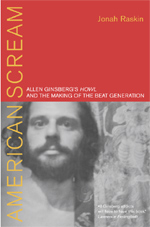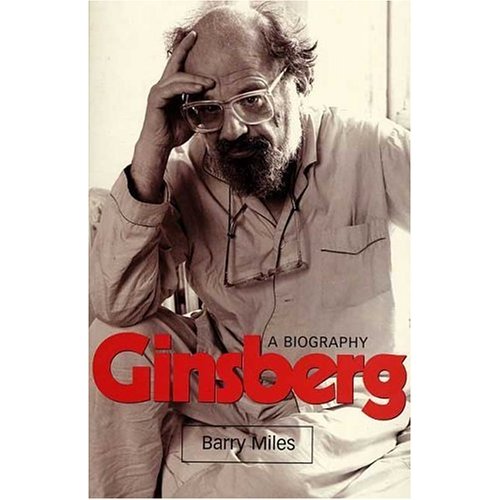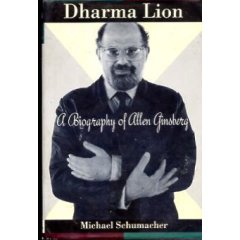 This week's class in The Beat Generation Revisted course was an introduction to the life and works of Allen Ginsberg, whose famous poem "Howl" inspired the title of Jonah Raskin's 2004 book (subtitled "Allen Ginsberg's Howl and the Making of the Beat Generation") and gave me the title of this blog entry. American Scream is an examination of the cultural roots of Ginsberg's great outpouring in poetry of what made his generation unique in its maladaptation to an American conformity. As a communication studies professor Raskin's primary interest is not in "Howl" as a literary work, but more in the effect of the poem on its contemporary society, as well as the personal development Ginsberg underwent before he could gather his ideas in this compendium of anecdotes about life as "angelheaded hipsters burning for the ancient heavenly connection to the starry dynamo in the machinery of night..." Raskin has, as the first scholar ever, had access to some unique background sources, such as psychiatric reports on Ginsberg, interviews with his psychoanalyst and extracts from the poet's journals:
This week's class in The Beat Generation Revisted course was an introduction to the life and works of Allen Ginsberg, whose famous poem "Howl" inspired the title of Jonah Raskin's 2004 book (subtitled "Allen Ginsberg's Howl and the Making of the Beat Generation") and gave me the title of this blog entry. American Scream is an examination of the cultural roots of Ginsberg's great outpouring in poetry of what made his generation unique in its maladaptation to an American conformity. As a communication studies professor Raskin's primary interest is not in "Howl" as a literary work, but more in the effect of the poem on its contemporary society, as well as the personal development Ginsberg underwent before he could gather his ideas in this compendium of anecdotes about life as "angelheaded hipsters burning for the ancient heavenly connection to the starry dynamo in the machinery of night..." Raskin has, as the first scholar ever, had access to some unique background sources, such as psychiatric reports on Ginsberg, interviews with his psychoanalyst and extracts from the poet's journals:
American Scream shows how "Howl" brought Ginsberg and the world out of the closet of a repressive society. It also gives the first full accounting of the literary figures--Eliot, Rimbaud, and Whitman--who influenced "Howl", definitively placing it in the tradition of twentieth-century American poetry for the first time. As he follows the genesis and the evolution of "Howl", Jonah Raskin constructs a vivid picture of a poet and an era. He illuminates the development of Beat poetry in New York and San Francisco in the 1950s--focusing on historic occasions such as the first reading of "Howl" at Six Gallery in San Francisco in 1955 and the obscenity trial over the poem's publication. He looks closely at Ginsberg's life, including his relationships with his parents, friends, and mentors, while he was writing the poem and uses this material to illuminate the themes of madness, nakedness, and secrecy that pervade "Howl".
Apart from these bios, there is excellent information to be found in the facsimile version of "Howl", edited by Barry Miles, in which one gets a full annotation of the poem by Ginsberg himself as well as background on the "Howl" obscenty trial, Ginsberg's struggle to correct the contemporary image of the poem as a nihilistic protest, instead of a spiritual credo, and much other invaluable material. Of course one must also own a copy of the original black and white covered City Lights Pocket Poets series edition of Howl and Other Poems which is still a cool object to carry in one's jacket or jeans pocket...
As for my lecture today I took my starting point in a clip from Bob Dylan's 1978 film Renaldo and Clara, showing Dylan and Ginsberg together at Kerouac's grave, discussing poetry, gesturing and walking about looking at the various mementi mori at the cemetery:
I thought it only appropriate to link back to last week's talk about Kerouac and his untimely death in 1969 of alcoholism-related causes, but also to point forward to the great connection between the Beats and the counterculture of the 60s with Dylan as one of its less willing figureheads. This connection gave me an occasion to explore the great meetings in 1965 (recently commented on by Todd Haynes' film I'm Not There) between Dylan, Ginsberg and The Beatles in London, where Ginsberg mediated as if he were a diplomat negotiating a peace treaty between two rival superpowers. Miles describes (p. 370) how Ginsberg managed to break the ice between the oversized egos of Lennon and Dylan by clowning around telling stories about William Blake, Jack Kerouac and the other Beats.
The relationship between Dylan and Ginsberg continued to be close, and Dylan helped Ginsberg take a step towards using music in connection with his poetry, teaching him a few chords on the guitar, and in general inspiring Ginsberg to approach other, more traditional forms, such as the blues - a popular form Ginsberg seems to have been unfamiliar with before meeting Dylan. In Don't Look Back, D.A. Pennebaker's well-known documentary of Dylan's tour of England in '65, Ginsberg takes part in what has really become an independent music video of "Subterrenean Homesick Blues" (it was also used as the original trailer for the film). While Dylan holds up and discards cue cards with the song lyrics, ("don't follow leaders, watch pawking metaws") Ginsberg is seen in the background vigorously debating with another individual, waving his arms and a weird shepherd-like walking stick about. The action all takes place in the back alley from the hotel they were staying at. This was only the first of Ginsberg's many cameo appearences with musicians over his career...
I went on to briefly mention some of Ginsberg's other activities in 1965, including the visit to three Communist countries (Cuba, the Soviet Union and Czechoslovachia) and getting thrown out of all of them (although in Prague the students crowned him King of May). I also pointed to Ginsberg's rapidly accumulating FBI-file, which didn't seem to reflect that since Ginsberg was treated as a dissenter and a misfit everywhere he went, it made little sense for the Feds to think he was some sort of Communist infiltrator and spy...
After this excursion into Ginsberg's ushering in of the 60s counterculture and passing the mantle of prophet and critic of America's contradictions on to a new generation, I returned to the main works of the mid-fifties Ginsberg, discussing how Kerouac's list of essentials for the production of spontaneous prose inspired Ginsberg during the writing of "Howl". The other raw material for "Howl" was of course personal experience, both from Ginsberg's childhood where he suffered greatly because of his mother's mental illness and his own troubled sexuality, and the more recent experiences from his circle of friends in New York, both at Columbia and Times Square, and later on in California.
In the facsimile version of "Howl" Ginsberg actually provides a rather elaborate line-by-line key to the anecdotal evidence immortalised in phrases such as: "who were expelled from the academies for crazy & publishing obscene odes on the windows of the skull" - references to Ginsberg writing on his dirty dorm window and getting suspended from Columbia for claiming that (Columbia President) "Butler has no balls". Many other otherwise obscure lines refer to specific incidents involving friends of Ginsberg, such as Philip Lamantia, Herbert Huncke, Joan and William Burroughs, Kerouac, or Neal Cassady (who famously is "N.C. - secret hero of these poems"). There is also a reference to Bill Canastra who was a legendary bohemian on the outskirts of Ginsberg's circle who decapitated himself by leaning out of a subway car while it was leaving the platform...
With regards to the structure of "Howl", Ginsberg insists in a letter to the critic Richard Eberhart that the poem is built "like a brick shithouse". By this he means that there is a solid, predictable construction of each of the 3 main segments and the so-called "Footnote to Howl". Each of the sections of the poem has a "fixed base" and a repetition-fueled structure: The "catalogue" of section I contains the anecdotes I referred to earlier, and they are anchored by the relative pronoun "who" initiating each line. Part II is a condemnation of "Moloch" - Ginsberg's name for the military-industrial complex which in Old Testament fashion demands a burnt offering of each citizen. This section ends with the speaker "abandoning" Moloch. This portion is the katabasis element of the poem, i.e. its descent into Hell. After that, part III features a statement of solidarity and brotherhood, where the direct address to "Carl Solomon!" is followed by the reassurance: "I'm with you in Rockland where...", repeated as the beginning of each line. Finally, in the Footnote (which really is the poem's part IV) we are back out of the mental hospital, and hear a list of all things holy, from the lowliest body part ("The tongue and cock and hand and asshole holy!") to the highest aspiration of a man: "Holy the supernatural extra briliant intelligent kindness of the soul!" This portion opens with 15 times "Holy!" and after that every line opens with the same incantation. This structure can be summarised in terms of language functions: Lament, Curse, Praise, Incantation/Prayer...
(By amazing coincidence, my friend Gray from Washington just sent me a news item that a hitherto unknown tape recording of Ginsberg reading "Howl" has been discovered in a university library at Reed College in Portland, Oregon! The tape will be available from the college website soon...)
After this in-depth survey of "Howl" we briefly discussed and heard some other poems, including "America", the funny tongue-in-cheek politics of which hinge on a parody of media stereotypes of "them bad Russians". In "America" Ginsberg still signs into the American project, putting his "queer shoulder to the wheel". The America outside his poem was less than forthcoming in accepting the help he offered.
We also discussed the role which some poetical predecessors have played as inspiration for Ginsberg. Here I singled out Walt Whitman, as the peripatetic American bard whom Ginsberg offered to follow early on: "Which way does your beard point tonight?" ("A Supermarket in California") (this post discusses Whitman and Ginsberg and the American Dream); Wiliam Blake whose voice Ginsberg heard in a vision, and to whom his "Sunflower Sutra" pays homage; and finally Oriental traditions, both within religious thought and poetic practice (for instance the haiku).
In closing we heard Ginsberg perform his moving "Father Death" (taken from a 90s BBC program) where he plays the harmonium and sings this simple lyric about accepting and embracing the inevitability of death for all. Thus we started the day at Kerouac's grave and ended with a celebration of both life and death. Ginsberg passed away in 1997...
Ginsberg at Academy of American Poets
Ginsberg at Levi Asher's Literary Kicks
Ginsberg at Modern American Poets





